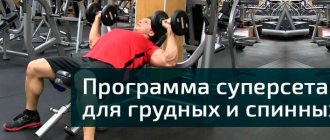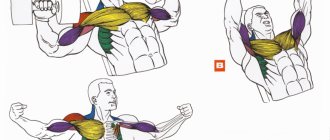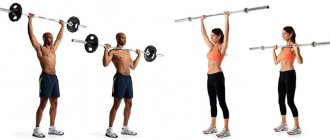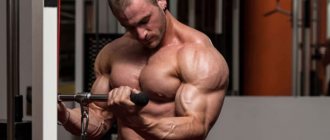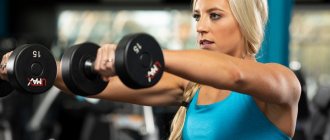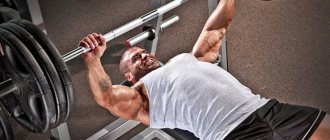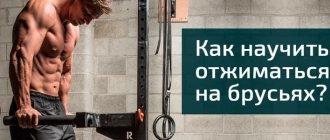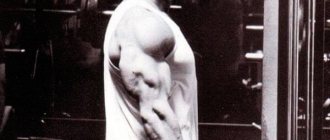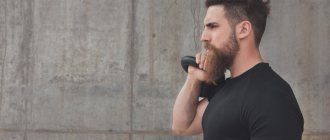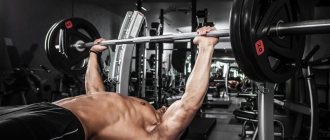Traditionally, training programs divide the body into muscle groups, implying that each of them is worked on a specific day. However, this division does not take into account the fact that when performing most strength exercises, muscle groups work together.
An alternative is to differentiate between pushing and pulling movements. In this case, the chest, triceps and shoulders are combined into a “push” workout, and the back and biceps are combined into a “pull” workout. What are the advantages of such a program and is it effective?
Muscles of the shoulder girdle
The following muscles belong to the shoulder girdle:
Deltoid.
It is they who are of greater interest to us. Located on the upper part of the shoulder. A kind of muscular shoulder pads that protect the shoulder joint. In the sports world, they are usually divided into 3 heads (bundles).
- Front
. Responsible for raising the arms in front of you (shoulder flexion) and rotating them inward. It also participates in the horizontal adduction of the arm, together with the pectoral muscles. - Average
. Its main function is to raise the arm upward from the sides (the other heads also take an indirect part in this). It is she who is responsible for the width of the shoulder. But this does not mean that we will focus all our efforts on working it out. - Rear
. The development of this head is lagging behind in almost all athletes (professionals do not count). It is an antagonist for the anterior head. That is, it performs the opposite function. Namely, shoulder extension and horizontal abduction.
This muscle performs various movements. Both of a pressing nature and a traction one.
Teres major and minor muscles
These muscles are also classified as the shoulder girdle. They are located under the shoulder blades. But they don’t have much interest in shoulder training for us. Since it is well worked out in many exercises aimed at developing the back. For example, in PULL-UPS and LATCH READLES, the large round one is involved. And in the LOWER BLOCK ROAD or BELIEVE ROAD, it’s small.
All other small muscles such as:
- Supraspinatus
- Infraspinatus
- Subscapularis muscle
They are well worked out during delt training. Only the infraspinatus muscle requires special attention. Because if the shoulder position is incorrect, it can be injured. For example, during an overhead bench press, the humerus collides with the acromion of the scapula. This leads to compression of the infraspinatus muscle. Which ultimately becomes the reason for its replenishment.
Technique for performing a special bench press
And it is done as follows: if the bench is adjustable, adjust the height, place the bar on the main mounts, select the weight you need, lie on the bench, take the barbell with a wide or medium-wide grip, remove it from the mounts and slowly lower it until the bar touches your chest and lift it to the limit of arm extension .
It would seem that the bench press is not difficult to perform, but despite its apparent simplicity, performing this exercise correctly is very difficult. More than 60-65% of people involved in muscle training do this exercise not quite correctly. Even experienced trainers and instructors do not always know the correct method.
This is not due to the fact that most of them may not be competent, but only to the fact that the correct method is more complex than the standard one. It requires greater coordination of movements, clarity, coordination and muscle development. For beginners, this method can be complicated and even inaccessible, traumatic and ineffective at first glance. Trainers and athletes of muscle training who have just entered this sport; advanced or even experienced are the same people as us.
Key points when creating a training program
Warm up at the beginning of the workout and calm down at the end
This is a very important point, especially if matters concern the shoulders. This area is most susceptible to injury. Therefore, before you start training, you should take time to warm up. This may include: circular rotations of the arms, raising and lowering them. Our main task is to warm up the deltoid muscles. This will make them elastic and the joints more mobile. And of course it will improve blood circulation. Also, you should include several stretching exercises in your warm-up. At the end of the workout, we make sure to perform calming exercises. Thanks to them, our body will gradually return to normal operation. Stretching reduces muscle pain during recovery.
We give preference to basic exercises
This is especially true for athletes at initial and intermediate levels of training. Before you start working on muscles in isolation and shaping their shape. We need to create muscle mass. And there is no better remedy in the world than basic exercises. They are the ones who give our muscles the necessary stress and hormonal surge. Which affects their growth. Therefore, we begin our training with heavy basic exercises. After all, their implementation requires much more effort. And there are most of them at the beginning of training.
We start training with lagging muscle groups
It is very important to follow this rule. Since most athletes forget about this. And then, one of the delta bundles begins to dominate, while the others lag behind. This will affect not only the shape of the muscles, but also their performance. You don't have to look far for an example. Pay attention to the people working out with you at the gym. In the majority, you can notice a pronounced lag in the rear deltas and overdeveloped front ones. All this is a consequence of an incorrectly constructed program. Therefore, you should start training with lagging muscles.
Training volume should be minimal
And this is very important. The deltoids are very small muscles that work in any exercise. Unless of course we are talking about leg training. But even there you can find exercises where the deltoids receive static load. Besides the gym, we have responsibilities at home and at work. Rearrange furniture in the office, dust the top shelves, or carry bags from the store. All this also loads our deltas. And if in the gym we start training already tired muscles with 5-6 exercises. Eventually, we will get injured. And our training will end there.
We use both pressing and pulling exercises
I said earlier that each deltoid head is responsible for its own function. And if we only perform PRESSES WITH A BAR or DUMBBELLS, we will never achieve full development of all 3 beams. Therefore, training should be balanced. Which has room for bench presses and rows. We'll figure out what this looks like in real training a little later.
Perform each set in the mid rep range.
In bodybuilding, for many years now there has been a war between athletes who promote high-repetition and low-repetition training regimens. The first ones advise performing 20-25 repetitions in each approach with a weight of 50-70% of the maximum (which we can lift just once). Others argue that you need to perform it a small number of times, about 6-10 repetitions per set, and take a fairly heavy weight. In their own way, they are all right. And each of the proposed modes can bring results in one or another training period. At the initial stage, it is best to choose a middle ground. And perform the exercises 10-15 times. So we will adhere to average standards for the time the muscles are under load. This is approximately 30-40 seconds. Therefore, the result is guaranteed to us. And of course, working in this range of repetitions, you can work out the technique without fear of overloading the shoulder joint.
Beginners should not train their shoulder muscles separately.
I think many people will now disagree with this point. How then will the deltoid muscles develop if we do not train them? Everything is very simple. Mainly for beginner athletes, CIRCULATE TRAINING is great. They are also called full buddies. That is, working out the whole body in one workout. The most effective basic exercises are used for this. And the same PUSH-UPS and BAR PRESSES involve the front delta. And if this load is not enough for a professional athlete, then for a beginner it is quite enough. When training the back, doing the BENT-UP BAR PULL, we loaded the rear deltoid. And the middle head is indirectly involved in performing STEPS. As you can see, even without doing specialized exercises to develop the deltoids, they will still develop. Of course, after 2-3 months, this load will no longer be enough. Then, you can think about additional load.
Your stadium is always nearby
Bodybuilders did not always have effective modern sports equipment. But pumped up, beautiful and healthy people have always existed, since antiquity. There are a huge number of exercises for developing various muscle groups in seemingly cramped home conditions. They are performed both with and without the simplest sports equipment, using only the weight of one’s own body as a load. The main condition for achieving results is regularity of exercise.
Such “pieces of iron” as one-pound, one-and-a-half and two-pound weights have always been in honor among Russian heroes. Kettlebell lifting competitions still attract a large number of participants and fans today.
Shoulder exercises
We have already decided that in shoulder training the entire emphasis will be on the development of the deltoids. Therefore, the exercises proposed below are intended exclusively for their training.
Barbell press standing (sitting)
Overhead presses are the most common exercise. It involves 3 deltoid bundles at once. But the main load goes to the front and middle. Performing a standing barbell press is more basic. Since not only the deltoid muscles are loaded, but also the core (abs) muscles. This option is perfect for both beginners and professional athletes. The seated press will deprive us of such benefits. But the load on the spine will be reduced. And the exercise will become more isolated. So this option is more suitable for professionals. As for the head press, I will only say the most important thing. This style of execution is very dangerous, since the movement occurs in an unnatural plane for the shoulder joint. And most importantly, this risk is not justified. Therefore, it is better not to use it in your training.
Dumbbell press sitting (standing)
Like the barbell, dumbbells are also one of the main attributes of the gym. Although this exercise is very similar to the previous one, there are significant differences.
- Firstly, the range of motion will be much greater than when working with a barbell.
- Secondly, each delta (left and right) will work independently of each other. Which will help eliminate the imbalance in development. This is useful for those athletes in whom one of the deltas dominates in development.
- Thirdly, to control the dumbbells relative to each other, a large number of stabilizer muscles are involved in the work.
Otherwise, the technique is similar to the previous exercise. A large load will be placed on the front and middle deltas. The weight of dumbbells will be much less than when working with a barbell. But thanks to the large amplitude, the load on the muscles will remain the same. And maybe it will even increase. These exercises can be alternated. Doing dumbbell bench presses in one workout and barbells in another.
Wide grip barbell row
This exercise is aimed at working the rear and middle deltas. It will fit perfectly into our training program. But to get the most out of it, you need to adhere to some rules.
- The grip should be wide so that the trapezoid is not included in the work.
- Due to the position of the body, we can change the load between beams. When bending forward, the rear delta is more involved. With a level body position, average.
You should not take a heavy barbell from the very beginning. This will greatly affect the technique. And instead of working the deltas, we will load the back and trapezius. This means our shoulder training will go down the drain. We'll be wasting our time. Therefore, at the initial stage, we are working on technology. Thanks to it, we will be able to use the muscles that we need.
Pull of the upper block to the face
But this is an isolated exercise aimed at developing the rear delta. It is perfect for athletes who do not feel their muscles working. This happens due to poor neuromuscular connection between the brain and them. Of course, beginners shouldn’t lean too heavily on it. Since you won’t be able to gain muscle mass using facelifts. But professionals often use it in their training to give their deltoids an ideal shape. This exercise is performed on a block simulator with a cable handle.
Dumbbell lateral raises
This exercise is also isolated. With its help you can perfectly work out the middle delta. I think many of you have noticed that this bundle is involved in all of the above exercises. Therefore, to achieve it, you can do dumbbell raises to the side. The main thing is not to chase weight. At the beginning, the technique must be worked out to the smallest detail. Since the delta is easy to injure. We can perform the wiring while standing, sitting, and with each hand alternately. It is better, of course, to alternate these exercises at least once a month. This will make your workouts less monotonous.
Of course, this is a small fraction of all the exercises that athletes use to train their shoulders. But they are enough to build up the muscle mass of the deltas and give them a ball-shaped shape. And then, you can add exercises such as: TILT SWINGS, DUMBELL RAISES IN FRONT OF YOURSELF, ARM BREAKS IN A CROSSOVER or EXAMINER. To get acquainted with them, just click on their name.
French Bench Press: Correct Execution
Well, what athlete doesn’t know about the French bench press? This exercise is considered basic for the development of triceps. Performing this exercise is not difficult, but for some reason this particular exercise is an exercise that is often performed incorrectly.
This article will talk about the myths of performing this exercise. Since so many people interpret doing it incorrectly as doing it correctly, this topic can be quite useful for beginners. How to do this exercise correctly:
- The bar is placed either on a special bench with fastenings for a French press, or on a bench for a press on the middle part of the chest and the athlete lies in reverse, where the body is on the bench and the legs are bent on the floor.
- The required weight is placed and the bar is carefully removed from the supports. It is advisable that there is always a partner nearby, and that the load is secured on the bar using clamps.
- Take the bar with a slightly narrower grip, relative to the average one, and slowly lower the barbell, from the limit of arm extension to the level where the center of the bar almost touches the head.
When performing the exercise, you should not spread your elbows to the side or make sudden movements. Particularly important in this exercise is the ability to keep the shoulder part of the arm motionless. For these purposes, a partner can hold them until the performer learns to restrain their movement independently.
Examples of shoulder training programs
Now that we have all the components, namely: knowledge of the anatomy and biomechanics of muscles, a plan for drawing up a training program and the necessary exercises. Putting all this together, we can create a training program.
Training for beginners (just coming to the gym)
As I said before, for beginner athletes there is no point in performing separate exercises to train the shoulders. Since their deltas will already receive the necessary load. After three months, slowly add one exercise at a time. Starting with the barbell press. That is, we begin to move on to full training.
Training for beginners after 3 months
After three months, you can slightly modify your training. To do this, you need to break the body into muscle groups. We are talking about: chest, back, legs, shoulders and arms (biceps, triceps). It is generally recommended to exercise three times a week. For example, on Monday, Wednesday and Friday, all other days are days off. Or Tuesday, Thursday, Saturday. Choose a schedule that suits you best.
First day
- Difference 5-10 minutes
- Exercises for chest. About 2-3.
- Standing barbell press 1 warm-up and 3 working, for 12-15 reps
- 2 biceps exercises
- Calming exercises 5-10 minutes
Second day
- Warm up 5-10 minutes
- Back exercises 2-3
- Barbell rows to the chin 1 warm-up and 3 working, for 12-15 repetitions
- Triceps exercises 1-2
- Calming exercises 5-10 minutes
The third day
- Warm up 5-10 minutes
- Leg exercises 3-4
- Shrugs for trapezius development
- Dumbbell lateral raises 1 warm-up and 3 working, for 12-15 reps
- Calming exercises 5-10 minutes
Shoulder training intermediate level (after 7-9 months)
Now we can highlight the definition of the place for our shoulders. That is, train all three heads on one training day. This is best done together with the chest or legs.
- Warm up 5-10 minutes
- Exercises for legs or chest
- Standing barbell press
1 warm-up and 3 working sets, 12-15 reps - Rows to the chin 1 warm-up and 3 working, for 12-15 reps
- Dumbbell raises to the sides : 1 warm-up and 3 working, also for 12-15 repetitions
- Calming exercises 5-10 minutes
The exercises can be replaced if desired. For example, in a standing press, take dumbbells instead of a barbell or do the exercise while sitting. Pull to the chin, row of the block to the face. And the extension to the sides, do it in turn with each hand. Or lying on an incline bench. All this will help your deltoids, which constantly receive new stress. What will give impetus to muscle development.
Shoulder training for professionals
Professional athletes train 4-6 days a week. And therefore, for the shoulders, they can set aside a separate day. This will allow you to perform larger workouts with more exercises. They also use two-sets and tri-sets (performing 2 or 3 exercises in a row). Basically, the training of professional athletes is purely individual and tailored to the characteristics of each of them. I'll give you an example of what training might look like. So that you know what to start from.
- Warm up 5-10 minutes
- Barbell rows to the chin 1 warm-up and 3-4 working reps for 8-12 reps
- Seated dumbbell press + chin block row 1 warm-up and 3 working two-sets for 10-12 repetitions in each exercise
- Dumbbell lateral raises 1 warm-up and 3 working reps for 12-15 reps
- Standing barbell press 1 warm-up and 3-4 working for 12-15 reps
- Calming exercises + stretching 5-10 minutes
This workout focuses on the rear deltoid. Since she most often lags behind in development. If we want to use the front head more, then it is enough to do bottom-up training. If for you this volume is very large (and with natural training it will be so). Then feel free to remove 1-2 exercises and train in the mode that is more comfortable for you. Our main task is to try not to overload the shoulder joint.
Good luck to everyone in your training!
How to improve your progress with sports nutrition?
The main problem for athletes who do not make noticeable progress is the incorrect distribution of priorities. It is important to understand that not only training, but also nutrition, recovery and lifestyle have a significant impact on muscle growth. Even if you give 100% and spend a lot of time in the gym, this does not mean that muscles are guaranteed to grow.
Unfortunately, not only the diet, but also the quality of the products very often leaves much to be desired. In this case, you cannot do without the help of sports supplements. However, you shouldn’t immediately run out and buy all the “magic jars”; not all of them will be relevant.
Among the primary and mandatory supplements are whey protein, vitamin and mineral supplements, creatine and BCAA. Optionally, you can add casein to the list by taking it before bed. Among the “effective but not essential” category are omega-3, beta-alanine and pre-workout supplements. This is something that will accelerate muscle growth, increase performance and increase the impact of training.
If we talk about maximizing the result, then it is highly advisable to add good test boosters and recovery supplements to the list. These supplements usually contain natural ingredients and often it is their effect that has the maximum effect on muscle growth and strength.
For those who are just deciding whether they need sports nutrition, we recorded a video below:
We recommend: online sports nutrition store https://fitmagazzine.ru/. Take what works!
